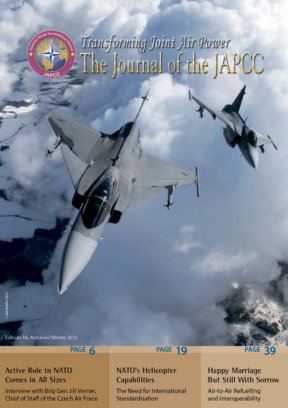Editorial
“Man will never reach the moon regardless of all future scientific advances.”
Dr. Lee DeForest, Radio Pioneer, 1957
Whilst not all predictions are as bold or naïve as the one above, the lesson is history has taught us that predicting the future with much certainty is fraught with difficulty. Likewise, knowing where or when the next conflict will arise or who it will involve is just as problematic. Nonetheless, if current trends are any indication, we can be fairly confident that forthcoming military operations will involve a multi-national and multi-institutional effort. In today’s complex security environment and with the fatigue of Afghanistan still fresh, nations will endeavour to prevent a future drawn out, ‘boots-on-the-ground’ struggle. With current fiscal limitations, this is understandable, but quick, decisive action, whether kinetic or non-kinetic, will still be needed. As we saw in Libya, Air and Space Power is uniquely suited for such a strategy.
With this in mind it is my pleasure, as the new Executive Director of the Joint Air Power Competence Centre, to reveal the sixteenth edition of the JAPCC Journal. We begin this edition with an interview with Brigadier General Jiří Verner, Chief of the Czech Air Force; whom we are indebted to for providing a privileged insight into developments within the Czech Air Force whilst also stressing the exceptional importance of Air Forces in military operations. Later we take a look at the Czech approach to maintaining a viable Ground Based Air Defence (GBAD) capability through modernisation and the possibilities of cooperation with neighbouring nations as a ‘Smart Defence’ opportunity.
In our Viewpoints section we build momentum with Smart Defence and / or Pooling and Sharing concepts with differing perspectives. Major General Jochen Both’s interview cites the European Air Transport Command (EATC) as a successful example of the pooling and sharing initiative whilst the following article focuses on Air-to-Air Refuelling, revealing both the broader political and practical military challenges. The latter suggesting that if nations are not willing or able to ‘pool and share’ their individual efforts to resolve the smaller issues, then there is little prospect of advancing the more ambitious projects and address the collective capability shortfalls.
I am particularly grateful to Dr. Griethe for his interesting article on laser based satellite communication for use in the high-altitude Unmanned Aerial Systems (UAS) domain. This emerging technology has the potential to enhance Intelligence, Surveillance and Reconnaissance (ISR) capability at a time when the demand for, and importance of, unmanned systems continues to grow. Elsewhere in this edition we look at enhancing NATO’s operational helicopter capabilities as well as the notion of expanding the role of the AWACS weapons system. We learn about potentially new Chemical, Biological, Radiological and Nuclear (CBRN) threats, discuss the challenges of Suppression of Enemy Air Defences (SEAD) in future campaigns, and peek at Hybrid Warfare as an out of the box viewpoint.
Joachim Wundrak
Lieutenant General, GE AF
Executive Director, JAPCC









